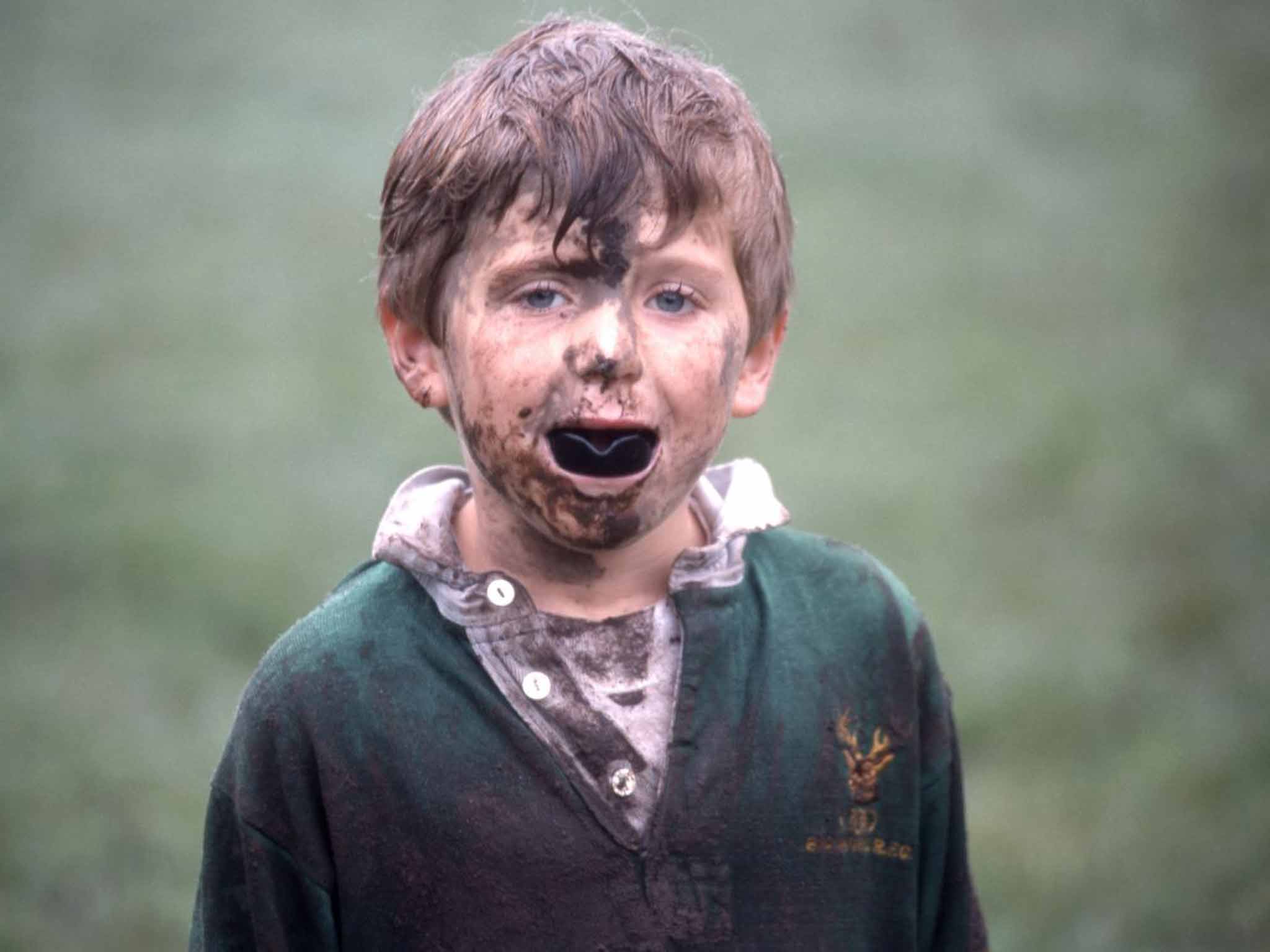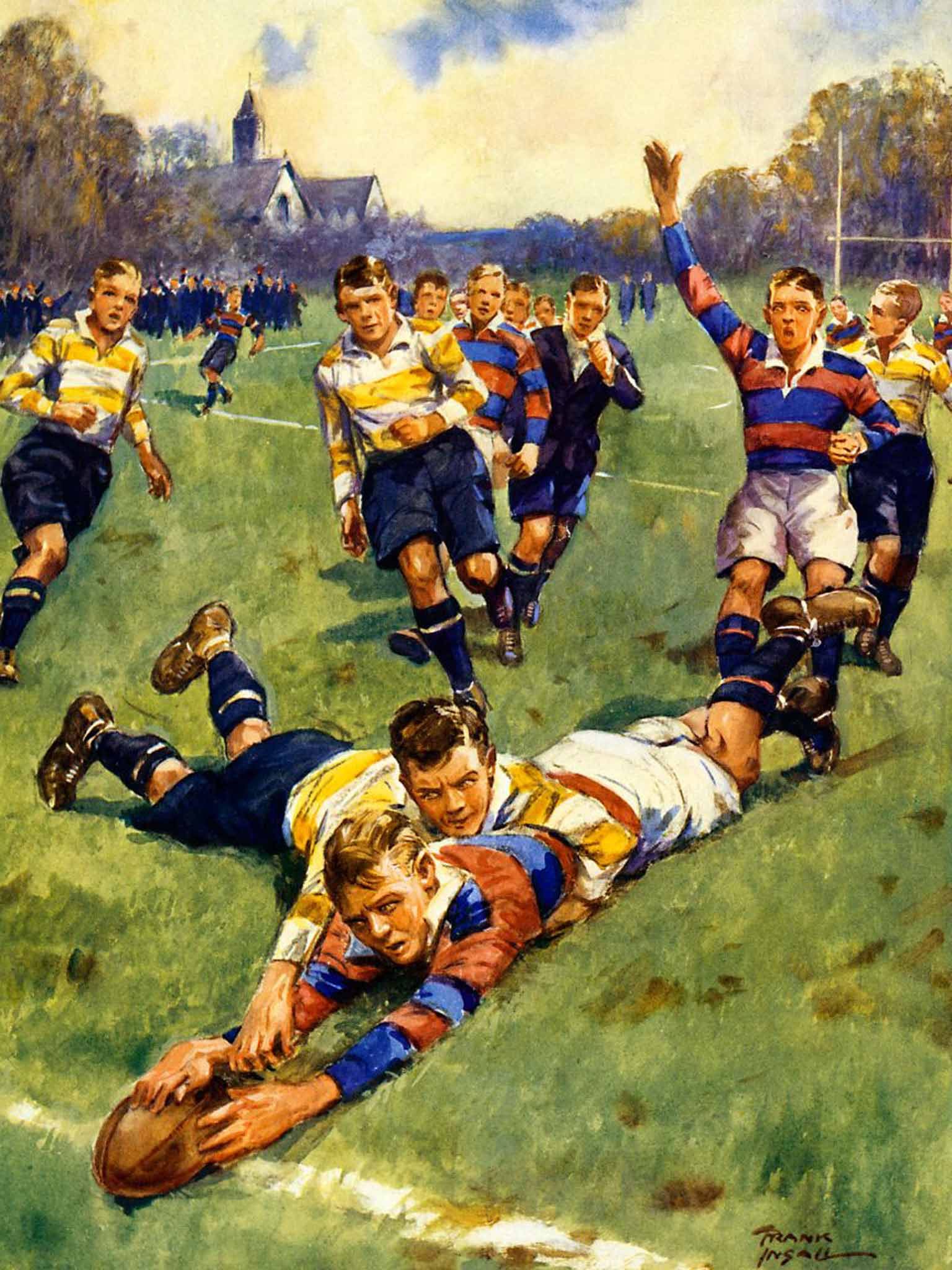Is rugby too dangerous for children to play?
After Allyson M Pollock's son suffered a spate of serious injuries playing the game, she spent a decade investigating the risks. The results were surprising and alarming. Here's what every parent needs to know

It is one of those perfect Saturday afternoons in early autumn in Edinburgh; low sun, a cool wind blows and behind the high, white goalposts, the Pentland hills form a glorious backdrop to the fine old oak and chestnut trees sheltering the pitch. Parents gather for the weekly ritual of watching their sons play rugby.
The air resounds with calls of "Tackle! Tackle!" as the opposition moves the ball swiftly out to the wing, stretching our defence. "Take him out," someone yells and a flanker launches himself at the winger's legs, bringing him down. Players pile in and suddenly the opposition's scrum half emerges with the ball and threatens to score; but the full-back tackles him high on the body and saves the day. It is an intensely satisfying moment for the team and for supporters.
Until, that is, we notice that the scrum half, still a child in the eyes of the law, stays down. Play stops. Is he concussed, a knee ligament torn, a shoulder dislocated, or is his neck broken? Referee and parents cluster around the still, silent boy. Players stare anxiously, then nervously look away. The referee takes out his mobile and dials 999. After what seems like an age, the ambulance comes to take the victim to the accident and emergency department. Sometimes, the game continues even when the child is taken to hospital.
Today, however, the game will not play on; this time, the injury is deemed too serious. It is many rugby parents' nightmare, and every rugby-playing boy's fear.
It is another injury but not necessarily another statistic. Rugby is a collision sport; it involves high-velocity physical contact and the risk of injury is significant. My own research suggests that children playing rugby have at least a one-in-six chance of being seriously injured during a season. A different study, from an A&E department in Ireland, found that 43 per cent of all sport-related injuries in secondary-school children were attributed to rugby: three times more than in any other sport. After the scrum, the tackle is the most dangerous phase of play and, being the most frequent, this is where the majority of injuries occur.
If each game were preceded by an incantation of injury statistics, a sombre toll of casualties from earlier games in the season, there would be no more shouts of "Tackle! Tackle!"; rather, a prayer of "Take care, take care". Unlike road collisions, rugby injuries are not monitored and data not collected routinely, even though rugby-playing schools collectively experience the equivalent of a multiple car pile-up of traumatic injury each weekend of play.
The Scottish Rugby Union, for example, only requires clubs to complete injury forms for serious injuries; those requiring hospital treatments. These statistics have only become available since the launch of the Are You Ready to Play Rugby? safety scheme in 2009, following adverse publicity concerning child rugby injury in Scotland. Because parents are not given proper data on injury, they cannot make an informed assessment of the risks to their children. And yet, surgeons in many parts of the country will tell you that rugby is comparable to the boozy Saturday-night brawl as one of the most common causes of smashed cheekbones and concussion.

I must confess to having a personal interest. I have a son who has been injured three times playing rugby, all before the age of 16. He has suffered a broken nose, a fractured leg and a fractured cheekbone with concussion. Until he was injured, like every other parent, I trusted the school and the authorities to look after him and not expose him to the risk of serious harm. When he started playing rugby, I did not ask about the statistics because I assumed that monitoring and audit would be routine.
But after his injuries, I soon found out that the situation was not so straightforward. A few mothers urged me on, saying that as a physician and a public health Professor (I was then Director of the Centre for International Public Health Policy and Assistant Principal at the University of Edinburgh), I was well-placed to uncover the facts, and that if I didn't, no one else would. So I began my search for information about rugby's harms and benefits.
Through the course of the search, we met sustained opposition and silence. And the more we pressed for answers, the more ferocious the resistance became. When my son's leg was broken in a tackle in 2004, I wrote to Scotland's Deputy Chief Medical Officer (CMO) to ask about injury surveillance and to express my concerns over what seemed to me to be abnormally high rates of injury on weekends. Not a week goes by in rugby-playing schools in Scotland without a group of boys hobbling down the drive on crutches or in plaster. I was puzzled not to receive a meaningful reply or any data.
A year later, my son had his face smashed in and a cheekbone badly broken during a game. I was shocked to the core by his deformed face: his shattered cheek, his eye drooping down and his inability to eat or drink anything but liquids through a straw. Much later, he would tell me that this third injury was a life-changing event that shook his confidence and affected his academic progress and other activities.
In 2005, feeling negligent as a parent for not considering the risks, I wrote again to the CMO's office asking for data. I also wrote to my son's headmaster and later met with him, the sports teachers and the school's parents' association. The headmaster's response was that monitoring was the responsibility of the Scottish Rugby Union (SRU), so I wrote to the SRU and a meeting was arranged at Murrayfield in the offices overlooking the new stadium.
I learnt from SRU staff that there was no injury data. Apparently, the secretary responsible had been ill for two years and no information had been collected or analysed. I contacted the school again and offered to do an audit of injuries, only to be told that the injury book was missing after a move of premises and there were no records. The school later retracted this, but would not give me the data.
In the summer of 2006, I decided to conduct my own investigation and audit by telephoning every parent and school-leaver in the 76-strong sixth-year of my son's school.
The results were surprising and alarming. Almost 37 per cent of boys had received an injury due to rugby, but the proportion of children injured increased with the level of the game. It is interesting to note that about two-fifths of the boys did not like the game and had either never played or had stopped playing as soon as they could (giving lie to the claim that the sport is universally loved and embraced).
For this group, 9 per cent had been injured by the time boys had reached the age of 17; whereas for those playing for the First and Second XV, 70 per cent had sustained at least one serious injury involving fracture, dislocation, ligament tear or concussion since their entry into secondary school five years earlier.
But these bare statistics do not convey the full story; some parents talked with anguish about their sons' permanent back and neck damage, of compound fractures, air ambulances, long journeys to hospital, anxious waits and time lost from education.
For too many, these were the indelible memories of schoolboy rugby.
In autumn 2007, I sent the results of the school audit and a brief literature review to the Chief Medical Officer, the SRU, the Health and Safety Executive, the Local Education Authority and the Children's Commissioner. There followed a flurry of phone calls expressing concern and then silence. No one wanted to take responsibility.
Sports injury is an extraordinarily neglected area. A child can have a cancer as rare as a hen's tooth but data will be collected on each and every case, and rightly so. This does not hold for sports and rugby injuries. In this sphere, public authorities are not obliged to provide sound information about the risks of injury so that teachers and schools, with a duty of care to children, can take preventative measures.
Yet schools and education authorities take special precautions to protect their wards against, for example, explosive and hazardous materials in the chemistry and physics labs; a school trip requires extraordinary vigilance by the school authority, the Health and Safety Executive and other public bodies.
But sport and rugby injury has few of the public-health precautions one would expect because the risks are treated differently and data are not collected. Many schools do not even enforce rules on wearing gum shields, which are still voluntary despite compelling evidence that they prevent injury. Rugby union is the most popular worldwide collision sport and participation is growing. Played predominantly by men, but increasingly by women and girls, rugby has raised concerns about its physical dangers for more than 30 years, owing to its exceptionally physical, high-impact nature.
The literature suggests that, too often, injuries to young athletes are dismissed as "a part of the game", rather than being seen as avoidable. Injuries can be expected to happen during any sporting activity; however, it is also true that a disproportionate number of injury incidents occur in rugby union, relative to many other sports. Exposure to this risk is not a simple matter of choice. In some schools, especially independent (public) schools, rugby is a compulsory part of the curriculum. Children have no option but to play, even when they do not want to.
General ignorance about the hazards of rugby is largely due to an absence of systems able to promote monitoring and data collection. Parents are not made aware that on the available evidence, for every season played, an individual's average risk of injury is 17 per cent or higher – that is roughly a one-in-six chance of being injured in a season – and the risk accumulates with exposure to play. It is highly unlikely that a rugby-playing child will complete their schooling without experiencing a serious rugby injury.
Neither is it generally known how much more aggressive rugby has become since the sport became professional in 1995, not only at the top level but among schoolboys. Studies report an almost doubling in the rate of injury since the game turned professional. Statistically, every 59 minutes a team member was injured during the 1997-8 season. In 1975, Jack Kyle, a former international rugby union player and surgeon, said: "Let us have no conspiracy of silence with regard to these serious injuries or to deaths on the rugby field. Our duty is to study the mechanisms of injury in all phases of the game. Then, and only then, will we be able to take preventative action."
Almost 40 years later, the conspiracy of silence endures and the monitoring systems are largely absent in the UK. This is despite medical journals, outspoken surgeons and coaches repeatedly drawing attention to the need for rugby injury surveillance over decades.
Physical activity in children is promoted extensively in Western countries, as it should be. But the associated risks and costs of injury as a consequence of participation should not be ignored.
Allyson M Pollock is the lead researcher for Public and Policy at the Barts Centre for Trauma Sciences, which conducts research, international education and dissemination programmes to improve care and outcomes of trauma patients worldwide
'Tackling Rugby', by Allyson M Pollock (Verso, £9.99), is out now
Join our commenting forum
Join thought-provoking conversations, follow other Independent readers and see their replies
Comments